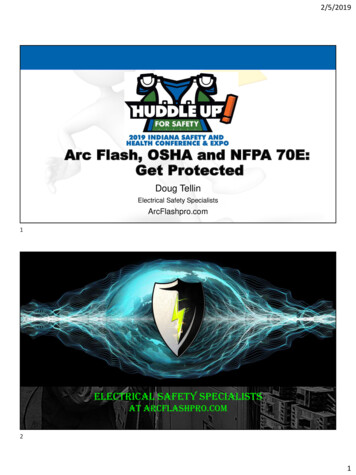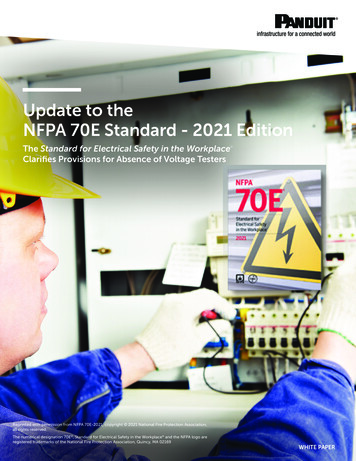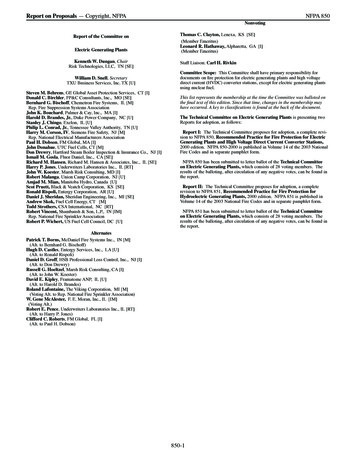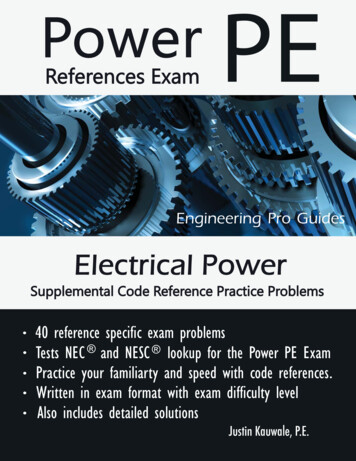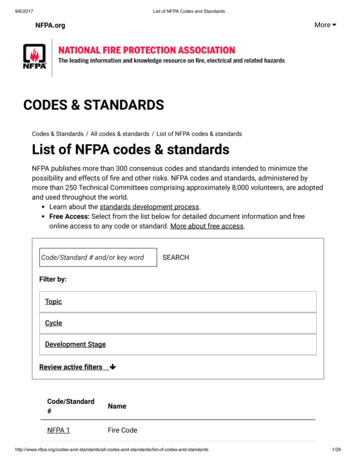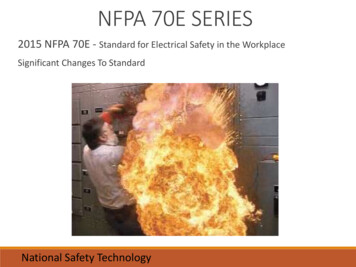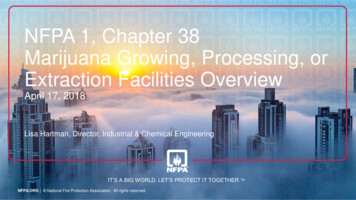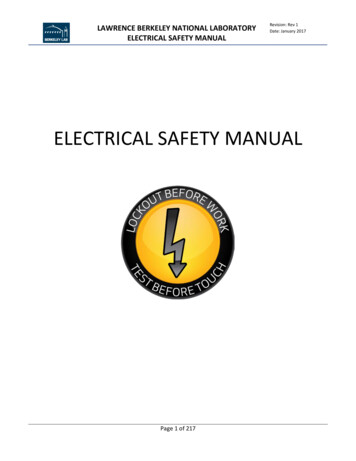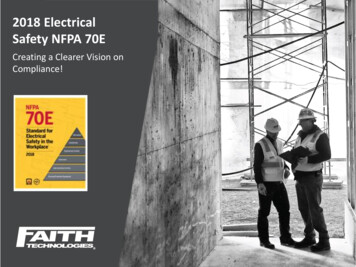
Transcription
2018 ElectricalSafety NFPA 70ECreating a Clearer Vision onCompliance!
Faith Technologies Contact InformationFaith Technologies, Inc.One Menasha Center Building201 Main StreetMenasha, WI 54952(800) 274.2345 ext. 6513Risk Department Management:Brian Downie – Group Division LeaderEric Dorn – Project ERM.com
Presentation Thoughts/Clarifications: We are here learn and share. Safety is one hugecollective think tank. Tap into your resource pool. For anyone who is sensitive, I apologize in advance . We want to have fun and share inputs as a group! We truly believe that most people just aren’t aware ofthis 70E topic in full disclosure or from multipleperspectives on what to put in place so hopefully wecan all take something away from today?
2018 NFPA 70E Training Agenda: Define Electrical Safe Work Practices Needs for“Qualified Employees” Discuss Key 2018 NFPA 70E Code Changes Review of PPE Labeling Content and What it Meansfor Employees – How Are We Using PPE Labels? Review Program One-Line Diagrams and How toInteract with Those for LOTO Planning Break from Class to Perform “Skills Based Training”Individually with “Qualified Employees” in theFacility. Can Each Qualified Employee get Equipment to a SafeWorking Condition?
Defining Our Perspectives on NFPA 70E:“Arc flash”It’s More Than Just a PPE LabelOur goal today is to not only help review the current 2018code but to also challenge “what we think we know”.From general experience over 18 years of helpingcompanies nationally we have witnessed some commonthemes or trends nationally to share with companies.Today we will cut to the core essential needs and build aproper foundation. From there everyone can then reviewarc flash as “one component” of the overall ESWP program.
NFPA 70E Clarification on Use vs. Compliance:Defining “Compliance”:The NFPA has no power, nor does it undertake, to police orenforce compliance with the contents of the NFPAstandards. Nor does the NFPA list, certify, test or inspectproducts, designs, or installations for compliance with thisdocument. Any certification or other statement ofcompliance with the requirements of this document shallnot be attributable to the NFPA and is solely theresponsibility of the certifier or maker of the statement.
Some Concerns with Today’s NFPA 70E ProcessCommonly Seen Nationally We Will Cover Today:“DATA COLLECTION” IEEE 1584 has language in their engineering standards whichdiscusses responsibility of data collection and today in the “arcflash” market, general data collection has become the normwith the Host Employer assuming all risk. The question is this? Is your equipment properly labeled andaccurate for LOTO? Or are we simply assuming that it is?Your engineering study is then based on that main assumption!
Scope Content & How to Dissect Them: Trends on “Data Collection” hold the host employer accountable for having accuratelylabeled equipment PRIOR to any vendor coming in. Be mindful of what is written inscope documents.
Common Concerns with Today’s NFPA 70E Process:Example: Customer A goes out on a bid request to do an “arc flash study” Theyunderstand the general need for engineering services, data collection, PPElabels and a report. In the course of securing proposals, who carries the responsibility of accuracyof equipment labeling is not covered nor do they talk about who will openand close equipment. Customer could end up hiring a resource who simply collected nameplatedata and the customer may still need to hire a contractor to come and openand close equipment too.
Putting the Perception Puzzle Together:1. When we think “arc flash” do we think Engineering?2. Instead of thinking “arc flash” should we start thinking ElectricalSafe Work Practices?3. IEEE 1584 is an Engineering guide to 70E and it does lean thatway in wording to describe how the technical engineering sidemay view the process.
2018 NFPA 70E Summary of Expectations: From the first several slides hopefully we have adifferent perspective on what NFPA 70E represents andhow we should reference it but not use it as ultimatecompliance? Hopefully we can all help others as we move forward inkeeping our vision on building overall program depth vsgetting lured into just the “arc flash” end of things. Again, “Arc Flash is More Than Just a Label”
2018 NFPA 70E Overview This edition of the code can be summarized as follows: This code has more wording and expectations regarding“HOW” we document activities and “What” methods weuse in communicating risks . The 2018 code in concept has the same common goal as allother past codes in that OSHA and 70E expect “qualifiedemployees” to get equipment to a safe condition . The definitions of qualified employee are important for usto discuss and agree upon between the employee andmanagement alike. These expectations should also bedocumented in job descriptions etc.
“Recent Electrical Survey Says” A recent survey of 1,200 electricians revealed some facts that canhelp set the tone for today’s training: Of 1,200 electricians who took this survey, 97% of them said they hadexperienced an electrical shock in the workplace. Of the 1,200 electricians surveyed, 26% of them said they witnessed anelectrical injury take place in their past experiences.Thoughts? Are we in general taking too many risks on a daily level or dowe simply now know what the real risks are? Did the 3% of people who claimed they never experienced ashock lying?
Safety Incidents Occur Daily: (6 to 10) MajorIncidents Daily!
2017 Top Ten OSHA Citations List:
Most Frequently Cited OSHA Standards: (#1 Midwest)#5. Control of hazardous energy (LOTO), general industry (29 CFR 1910.147) 3%Increase over 2016 in violations.
Safety Impacts/Loss Time:1 in 5 workersfrom the 14,000non-fatalelectricalincidents spentmore than amonth awayfrom work
OSHA Has Some Fairly Common Citation Themes:Common phrases “Electrical Safe Work Practices” “Personal Protective Equipment” “De-Energize”
Typical Control Panel Incident Video Example:
What Employee Group Should We Watch? . In safety we all can relate to one common theme.That general theme is as human beings, we all havesome tendencies and at times common traits. Which age group of employees has shown theypresent a higher risk in not following along withsafety expectations or policies?1. 18 – 252. 25 – 403. 40 - Retirement
What Employee Group Should We Support? . If most of you picked #3 in the options you aren’t aloneand commonly many people think that section of ourworkforce is where we should focus our attention. The answer is 25-40 and the statistics prove this to betrue from OSHA. When new programs get released thisgroup tends to not follow them as fast and can feel theirproductivity and past value to the company outweighssafety expectations etc .25 – 40
We “Don’t Know What We Don’t Know” . Employee used wasp spray on an exterior bus. Wasps diedalong with major injuries to the employee when the busfaulted as the nest fell onto live bus.
Are We Creative in the Electrical Trade?Field Modifications aresometimes necessary but dowe follow up to make themmore correct?Some of these fieldmodifications are darn rightgenius in the moment but notcorrect of course and then weget distracted and don’t goback to make them RIGHT .
And Just When You Think You’ve Seen it All?First place prize winner so farin 2018 on creativity.
How Qualified are We?25
NFPA 70E Training/Code Book Outline:The NFPA Code is comprised of three chapters:1. Chapter 1 (Safety-Related Work Practices)2. Chapter 2 (Safety-Related Maintenance Requirements)3. Chapter 3 (Safety Requirements for Special Equipment)For our training we are conducting today all of our time will befocused in Chapter 1 along with some comments on maintenanceof equipment at the end of the slide presentation. As we go through Chapter 1 content we will make a notation onwhich article we are discussing in the power point slide deck.
Article 105 (Chapter 1)Application of Safety-Related Work Practices andProcedures: Article 105 in summary discusses the application of programs foremployees to follow which are set up and managed by theemployer. This article is not large in content but establishes thebasis of responsibility.
Article 110 (Chapter 1)General Requirements for Electrical Safety-Related WorkPractices: Article 110 in summary discusses the application ofdocumentation and expectations that employers set up forqualified employees to follow for example starting out with:– Article 110.1 Electrical Safety Program starts out thisarticle section– Much of this entire article was created to help usdocument expectations of our programs and forqualified employees regarding training, riskassessment and job planning etc.– Not a simple task as we all can relate to challengeswith documenting just about anything we do right?
110.3 Host Employer Responsibilities:One of the easier OSHA related targets. As the Host Employer,Companies take on responsibility for contractors and how safe theyperform work.If an incident happens, do we have a documented job safety planbetween the host employer and contract employer?Contractor responsibilities also exist where the contract employeris also supposed to communicate safety planning and executionback to the Host Employer.Bottom Line: Don’t assume contractors are all up tospeed and make time to discuss and document howprojects are to be done according to your expectationson safety and NFPA 70E.
110.3 Host Employer Responsibilities:BottomLine: Don’tassumecontractorsare allthinkingthe sameor properwithsafety.
Article 110.1 – Safety Related Work Practices:110.1 in Safety Related Work Practices essentially says;How Do We Manage & how Do We Document?New Additions to the 2018 NFPA 70E Include:A. Inspection of Newly Installed EquipmentB. Condition of maintenanceC. Risk Assessment procedureD. Human ErrorE. Hierarchy of Risk ControlsF. Job Safety Planning and Job BriefingG. Job Safety PlanningH. Job BriefingI. Change in ScopeJ. Incident InvestigationsK. Lockout/Tagout Program and Procedure Audit
Article 110.1 – Safety Related Work Practices:Review:Key 2018 code additions here are changes with RiskAssessment Procedures and Job Safety Planning. What the code is saying in simple terms is we assumetoo much at times on what our staff is doing and if theyare truly qualified to assess their hazards and avoidthem. Both of these additions in the above two mentioned arekey indicators that NFPA is telling us we need to bebetter structured in how we communicate and planinternally on a daily or job specific basis etc.
110.1 Risk Assessment Procedure Outline:“Risk Assessments” essentially rely on one primary goal and that isthe employee is able to recognize or “Identify Hazards” .
110.1 Risk Assessment Procedure Outline:Thoughts: Has a place andvalue at times. Code book isn’tspecific onexpectationsregarding “everytask “or thosewhere qualifiedemployees getexposed to tasksoutside of theirnormal routines. I see this as oneadditional toolin our toolbox touse whenneeded.
110.1 Risk Assessment Procedure Outline:Thoughts: (Cont.:) Not to be confusedwith “EnergizedWork Permits” This assessmentform is simply away for qualifiedemployees to divedeeper into“evaluating” certainactivities. Example might be:Documenting somerisks for deenergizing a higharc flash risk itemlike mainswitchgear?
110.1 Risk Assessment Procedure Outline:(Recent Example) Qualified electrician was asked to troubleshoot a breakerdisconnect after a forklift had bumped the cabinet because thelights had gone out. In the process of turning off the breaker, the internal componentsfailed and the fault came out the handle. Could a Risk Assessment possibly have helped the employeerecognize the need for minimally leather gloves to help withpotential burn protection when he already knew something wasn’tright on the inside of that cabinet?
110 (I) Job Planning and Job Briefing:
Pre-Planning Activities is Crucial. How Can weImplement More Communication? Can this fitArticle 110 Needs? Don’t Rush Into Tasks: Human tendencies are to rush in and getsomething fixed. We have to guard against this!The 2018 NFPA code is requesting us to do Job Planning and Job Briefings
2018 NFPA 70E 110 Emergency Response CPR:Summary on Contact Release and CPR: The 2018 code now added a clarification that “thoseresponsible for responding” does not have to only include firstresponders. The employer needs to clarify who theseemployees are at each company to get training. Contact release is often not taught by common CPR companiesso employers will have to ask for this to be taught or teachcontact release internally so employees know how to getemployees who are electrically “hung up” or can’t let go freefrom the shock hazards etc. How to get employees free from hazards is something weneed to ask our CPR training resources .
2018 NFPA 70E 110 Emergency Response CPR:Little change totraining other than toclarify wording in« Contact Release »and also a clarificationin the InformationalNote.This tells me someemployers took the2015 code too literallyand only trained thosethat were truly firstresponders.It’s up to you to trainthose you feel areexposed to risks.
2018 NFPA 70E 110.2(C)2 on Emergency Response:Redcross has a good refresher training video ontheir website to utilize.www.redcrossrefresher.com
Article 120 (Chapter 1)Establishing an Electrically Safe Work Condition: Article 120 in summary discusses the most important focus thatwe can review with NFPA 70E and actually represents the onemain OSHA emphasis they will key in on when talking with anyqualified employee.– Article 120 starts out this article section withLockout/Tagout Programs and expectations forachieving a “Safe Working Condition”– Note: We feel differently in some regards withadditional emphasis needed than the current codebook is teaching in reference to expectations andprocedures we follow to get equipment to a “SafeCondition” and we will discuss those in upcomingslides.
Article 120.5 Process for Establishing and Verifying an“Electrically Safe Work Condition”This aspect of NFPA 70E is our main focus for trainingtoday with Faith Technologies. If we can demonstrate that as “qualified employees” wecan effectively get equipment to a “SAFE WORKINGCONDITION” then we have achieved the foundationalgoal of NFPA 70E and what OSHA is expecting of us. The slides are directly taken from the 2018 code bookand we will discuss what our Skills Demonstration formlooks like compared to what the code book is saying.
Article 120.5 Process for Establishing and Verifying anElectrically Safe Work Condition
Article 120.5 Process for Establishing and Verifying anElectrically Safe Work Condition (Cont)
2018 Article 120.5 (Process for Verification):1.2.3.4.5.6.7.Determine al sources of electrical supply or energy to the equipment.Check up to date drawings as requiredOpen the upstream disconnecting sources for each source of power.Release stored electrical energy if presentRelease or block stored mechanical energyApply Lockout/Tagout devices in accordance with established proceduresDetermine expected PPE needs for the piece of equipment you intend topower down. Obtain correct arc flash and shock hazard protectionincluding the appropriate voltage meter for upcoming steps.Use an adequately rated portable test instrument to test all aspects of thepower supply to verify upstream power has been eliminated. Meter shallbe tested on a known 120V power supply before and after LOTOverification steps to ensure the meter works properly
Article 120.5 Process for Establishing and Verifying anElectrically Safe Work Condition (Cont)There are many potential issues associated with thisintroduction within the code. Installing these meters willnot act as a substitute to the proper steps we take toensure power is absent inside equipment etc!
2018 NFPA 70 Code Insert on Devices:In past years we’ve seen LED indicatorsas quote “round one” from manufacturesto sell employers as a feel safeapplication. OSHA teaches “Point onPoint” contact testing with a qualifiedtest instrument and qualified employeewith “live dead live” formats to ensureaccuracy.New designs have now incorporated boththe visual and “Point on Point” contacttesting means to help makeimprovements.To rely on devices like these, we carryrisks also so. Who installs them, are theinstalled correctly, why do we need themand who verifies they work correctly?48
Video Links on Test Units:Video from PanduitSee TMXqjV1Jd?utm medium Email&utm source NA NL The Journal Apr 17 2017&utmcampaign Corporate Global XX EN Journal 2017&utm content NANL The Journal Apr 17 2017Video from Grace Engineered ProductsVoltage Test Station and Safe-Test Points Grace Engineered Products061316http://www.bing.com/videos/search?q Voltage Test Station and SafeTest Points Grace Engineered Products 061316 &qft filterui%3amsiteyoutube.com&view detail&mid 0FB89571946487197F2C0FB89571946487197F2C&FORM VRDGAR
2018 NFPA 70 Code Insert on Devices:This video from Panduit wewatched shows theyinstalled the device on the“LOAD” side of the controlpanel disconnect.One main concern withinsertions of codes likethese is that the generalpublic will install thesedevices and feel they havecreated a “safe workenvironment” but the realityis “ALL ENERGY” must beremoved from the enclosureso installing people aregoing to not be trulycompliant.50
2018 Article 120.5 (Process for Verification): Continued
2018 Article 120.5 (Process for Verification): ContinuedSo, let’s bottom line this general topic somehow It’s not a quick answer. Why are we going to install these? To protect fromwhat? They need to be installed by someone who understands how they workand can install and wire them correctly. How do we document this? They may be UL listed but what IEC 61508-1 rating do they carry for (SIL)?Safety Integrity Levels Example: We have roughly 1 billion people in the world and if we take off from a rocketship per hour based on safety standards from 13849-1 and the correspondingSIL ratings we can relate to it in this way. Ple 47 booms Pld 290 booms Plc 1700 booms Plb 5000 booms Pla 20,000 booms
What is the OSHA Focus on “Safe Work Practice”?Their focus is and has always been aimed at the overalltopic of: “Electrical Safe Work Practice!”What does this statement mean? Many of us refer to NFPA 70E as the reference guide for safetyand it is a good starting point. OSHA on the other hand has one main goal. The main question ishow are we managing ourselves and can we get equipment to a“safe condition” before work is performed. OSHA Sub Part S 331-335 references are often used. OnMaintenance of systems, 1910-303 is the primary source OSHAcan refer to on maintaining site equipment for operational safety. OSHA will rarely if ever come in and ask “How are you managing“arc flash” They want you to prove you can get equipment deenergized and safe.
2018 NFPA 70E Training Requirements (Qualified)Training Requirements Under Article 110.2 Training requirements continue to expand in the 2018 code Type of training and Documentation have been clarified more
How Do We Qualify Employees?:Can the staff employees effectively identify and avoid hazards and get equipmentto a “Safe Condition”.Only the Host Employer ultimately can deem the employee “Qualified”. Noexternal resource can do that for us officially.
Different Ways to Qualify Employees:
Skills Sheet: (Employee Guide “Electrically Safe”)Training for qualifiedemployee status is largelybased on the concepts of“show me”.In summary, we can havegreat safety policies andgood equipment labelingin place BUT if employeesdo not demonstrateeffective practice of oursafety needs, thisrepresents a problem withcompliance.
Obtaining a De-Energized State Correctly is ourPrimary Goal with ESWP and OSHA: This example shows a standard disconnectwith ideal labeling in place which in turnsupports the fundamental goal for anysafety program. If an employee was asked this question,how would they be able to respond? OSHA Question: If you had tochange a fuse in this disconnect,explain to me how you would dothat?58
Employee Scenario: But I’m Working Over on the Far LeftSide So Why Are You Saying I Have a Risk?If the main breakerdisconnect is on,the interpretation iswe still have apotential hazardwithin the overallenclosure.Why not just killpower up-steam?Then the entirecabinet is deenergized.
Article 130 (Chapter 1)Work Involving Electrical Hazards: Article 130 in summary discusses how we determine risks andwhich methods we have used to know our exact hazard levels. Italso is the largest article in Chapter 1 and includes multiple tablesassociated with arc flash and shock hazard tables along withexplaining the four hazard categories.– Article 130 starts out this article section withestablishing what is “Safe Working Condition” andarticle 130.2 is a key code reference we can use as abasis for internal conversations surrounding activitiessuch as troubleshooting vs. repair related work etc.– Article 130.5 is an article we reference on PPELabeling
2018 Code Version Article 130.2This article establishes our goal which is to getequipment locked out and safe before “work” isperformed.
Article 130.2 Normal Operations (Maintenance):Maintenance:Define “NormalOperation”?What is clear, is thecode is expressing theneed to addressMaintenance ofequipment. There aredirect ties to our arcflash outcomes basedon how breakers reactwhen called upon totrip etc.
Article 130.2 Normal Operation (Cont:)This Code Article brings up a challenging question. How do we address “ClosedDoor Switching PPE Needs”: Some people interpret closed door switching of breaker ordisconnects as if we should dress up to the same PPE levels asdetermined by “OPEN EXPOSURE” levels? Condition of our equipment is very important and to be clearthis code article has good intentions. However, it should be made clear in this training session thatregardless of how well maintained our equipment is, there isalways that potential for hazard within and we can never assumethat just because our equipment is in good condition that wewon’t experience a fault/failure.
Article 130.2(A)(4) Normal Operation (Cont:)Watch OEMlabeling also.Often we seegeneralizedlabels thatalso mirrorcommentsfrom NFPA70E:
Article 130.2 Normal Operation (Cont:)This Article Will Inevitably Bring Up the Age Old Question of “Closed DoorSwitching PPE Needs” and is a key topic when the code committee decides whatthe “likelihood” of an exposure might be etc.Here is what has commonly been used to define closed door risk managementand PPE needs. For known (calculated) HRC Levels of 0, 1 or 2 Recommended HRC Level 0 PPE for switchingprocedures For known (calculated) HRC Levels of 3, 4 or Dangerous Recommended HRC Level 2 PPE for switchingproceduresRemember the maintenance component discussed earlier and work with employeesto understand the importance of shedding load on a system before we re-engagebreaker disconnects.
Article 130.2 Normal Operation (Cont:)Before we move on, who has questions onthis “Closed Door” PPE operation topic? For known (calculated) HRC Levels of 0, 1 or 2 Recommended HRC Level 0 PPE for switchingprocedures For known (calculated) HRC Levels of 3, 4 or Dangerous Recommended HRC Level 2 PPE for switchingprocedures
Equipment Labeling is The MAIN Key Aspect to YourProgram Success!!! Good Formats Promote GoodBehavioral Employee Decisions. Think of a PPE label like a GPSroad map. If our PPE label gives ouremployees the right roadmap, then we can feelconfident the employee hasall the right info. If it doesn’t address all needsor give good direction we getlost .
Connecting OSHA & NFPA 70E – PPE Labeling Faith Technologies, Inc.
Labeling Goals for Arc Flash and Shock (LOTO)Programs Equipment Labeling should include three key components whichare: 130.5 does not view PPE labeling from the ESWP process for LOTOgoals however our views on LOTO align with OSHA expectations for“Safe Work Practice”. Summary, One PPE Label, all Inclusive forgoals on ESWP!!!1. Complete Arc flash hazard ratings and PPE needs2. Shock hazard ratings and glove needs3. What is my equipment name? & Where do I turn offpower?
Labeling Goals for Arc Flash and Shock (LOTO) ProgramsPart #1: Complete Arc flash hazard ratings and PPEneeds so employees can perform their activities withoutquestioning what is exactly required.Many PPE labels we see often are ok with thiscomponent of the 70E topic. Some however may referyou to the code book for PPE selection based on thevendor you chose?
Labeling Goals for Arc Flash and Shock (LOTO) ProgramsPart #2: Shock hazards and PPE needs associated withthe voltage employees may be exposed to.Generally vendors rely too much on software systems tocreate PPE labeling so shortcuts are common.Missing glove ratings
Labeling Goals for Arc Flash and Shock (LOTO) ProgramsPart #3: NFPA 70E does not comment on the corevalue PPE labels can bring or how they could tie intothe overall ESWP process.Generally equipment labeling and upstream Lock Outsources are either not present or questionable for truevalue. This part of the PPE label starts creates safetyvalue and direction for your program!
Labeling Should be Considered as a Good Road Map!NFPA 70E sometimesgets stuck on pieces ofa topic but fails tomention how they allshould work together.This PPE label maysatisfy some veryminimal need to saywhat the arc flashrating is but what elsedoes it help with?
Machine Specific vs Electrical Upsteam LOTO Goals:Correct Upstream Electrical LOTOPoint for ESWP MeansCommon Equipment Disconnect
Check Your LOTO Procedures (Mechanical vs Electrical):Commonly if OnlyE1 is listed on theLOTO sheet theprogram is moremechanical based.On this PPT exampleE1 is correct butcommonly we seethe equipmentdisconnect onlylisted!
Can Our Employees Relate with Boundaries and Risk? As qualifiedemployees, dowe allunderstand thehazard boundaryinformation andwhat the shockand arc flashlevels mean indistance?!WARNINGArc Flash and S hock HazardAppropriate P P E Required34 inch3.46Class 1 Do we know howto process a PPElabel and theinformationprovided?Flash Hazard Boundarycal/cm 2 Flash Hazard at 18 inchesVR Gloves-Tools, Proper Clothes, Safety Glasses,480 VACHardhatShock Hazard when cover is removed42 inchLimited Approach12 inchRestricted Approach1 inchProhibited ApproachBus Name: PP-MCC-G81, Prot Device: PP-PDP-G71-6Flash Boundary – CalculatedLimitedRestrictedWarning labelprovidesboundaryinformation
130.5 (H)Equipment Labeling Codes for 2018 Edition:(1) Nominal system voltage(2) Arc flash boundary(3) At least one of the following:– Available incident energy andthe corresponding working distance,or the arc flash PPE category in table130.7(C)(15)(a) or table 130.7(C)(15)(b) for theequipment, but not both.We will discuss this– Minimum arc rating of clothingconcept further inclass. General theme– Site-Specific level of PPEis to differentiatewhich method theemployer chose onPPE determinationsetc.
Overview of Informative 2018 PPE Label Format:Complete Statements inPPE listingsShows When Glovesare needed. Prohibited ApproachBoundary was eliminated for 2015Supports ElectricalLOTO NeedsDate Optional for 70EShows Fault Current Levels to Aid in Breaker Applications
2018 PPE Label Format (Look) Changes:Why is 2018 code now saying weshouldn’t say what “category” our PPErisk levels fall within If we’ve done aformal ESWP audit and calculated truecal/cm2 exposures . The code committee is essentially creating a differentiator in PPE labelsbased on what method we used to determine the risks. If we are an employer who uses the code book to select PPE levels thenwe can use the wording “category” and keep that on the PPE label If we do formal ESWP auditing and calculated exposures then we cannotuse the wording “category’.
Does Engineering PPE Labeling Content Equal Compliance?Many PPE label formatsdon’t fully disclosevaluable PPEInformationProtective Device Nameswill often not representtrue LOTO points in asystem so be careful onwhat your labelsreference here.
General PPE Levels (Minus HRC 0):CategoryRequired Protection FR ClothingCategory 0*Untreated Cotton Long Sleeve Shirt,Pants, Safety Glasses, HearingProtectionCategory 1AR Shirt, AR Pants, Hard Hat, 4cal/cm2 Face Shield, Safety Glasses,Hearing ProtectionCategory 2AR Shirt, AR Pants, Hard Hat,Balaclava/Hood, 8 cal/cm2 FaceShield, Safety Glasses, HearingProtectionCategory 3AR Shirt & Pant AR Coverall,Switching Hood, Safety Glasses,Hearing ProtectionCategory 4AR Shirt & Pant AR Coverall,Double Layer Switching Coat andHood, Safety Glasses, HearingProtection2018 Code againdoes not discusswhat we used torecognize asCategory 0*The need for naturalfibered garmentsand general PPEhowever has notchanged!!
Arc Flash Categories as Referenced in the Code:The levels of PPE in concept when we talk about “categories” has remainedconsistent from the 2015 Code.
Table 130.7C15c on PPE Levels: No Changes in 2018Table 130.7(C)(16) Protective Clothing and Personal Protective Equipment (PPE) Remember this table no longer defines PPE Category 0 however we are stillenforcing the minimal PPE expectations on labeling such as Cotton Clothing,Safety Glasses and hearing protection etc.!
2018 Article 130.5 “Picking a Path on Arc Flash Methods” The code book gives us two methods to select PPE and assess risklevels. The code book PPE category Method or doing Incident EnergyAnalysis
NFPA 70E Clarification on Use vs. Compliance: Defining “ompliance”: The NFPA has no power, nor does it undertake, to police or enforce compliance with the contents of the NFPA standards. Nor does the NFPA list, certify, test or inspect products, designs, or installations for compliance wi
